Archive for the ‘Weight loss’ Category
Believing And Having A Plan Will Change Everything!
January 11 2017
It’s a proven fact that 90% of traditional diets fail, so what is your chance of succeeding with a diet you may be considering for weight loss, or weight control?… 10%…. that’s all!!
Losing weight is one thing, keeping it off is another.
Planning is the key to your success; having a plan that is specific to losing weight is the ultimate solution to maintaining healthy weight for life.
BELIEVING CAN CHANGE EVERYTHING!
Believe that your decision today will make a huge difference in your life. It will be inspirational and rewarding experience bringing an incredible transformation into your personal life.
Your health; your family’s health; your family life; your self-esteem, all being affected.
- Believe that it is about the food we eat. How much we eat plays a role to some degree, but what we eat is what matters the most!
- Believe that healthy food can also taste good. Preparing your own food allows you to modify the taste to your liking, still keeping it healthy. Preparing your own food can also be so much fun and above all, it’s rewarding.
- Believe you can do it. Frustrating!? Trying to eat the right food can be frustrating. Having a plan to guide you in making decision with what to eat every day is the key.
Planning is smart; Planning is time saving; Planning is money saving, but about all planning gives you an overview of what you eating not just one day, but over several days which is what is important in achieving the ultimate control over your food consumption.
BUT, YOU MUST BELIEVE!
How do we know?
Well, 12 years of being involved with people like you, trying to make sense of where to begin and then how to make healthy eating a way of life, gave us a true sense of where the problem is and why weight problems have now reached epidemic proportions in North America.
The MealEasy® Weight Loss Meal Plan will help you to facilitate the change you may be considering. We have developed MealEasy to help people to achieve their goals. Why a plan? Because… “A goal without a plan is just a wish.” ― Antoine de Saint-Exupéry
For fast facts and helpful tips, please read on.
Sobering Facts About Being Overweight – What Can One Expect
- Significantly Shorter Lifespan
The top causes of death in the United States by far include heart disease, cancer, stroke, diabetes and dementia. They are all linked to being overweight. A recent 2014 study at McGill University, published in The Lancet Diabetes & Endocrinology found that being overweight shortens one’s life by almost a decade! Think about that for a moment… - Many Years Of Reduced Quality of Life
Not only that, but the study also found that it deprived people of 19 YEARS of healthy living! Imagine what you could do with those extra years! - The Problem Getting Worse
If that wasn’t enough, the obesity epidemic is getting worse! Efforts to slow it down are not working, because the root cause (the poor quality food choices we make) is continuing to be ignored. For the first time in roughly 20 years, a National Center for Health Statistics (NCHS) study has shown a decline in life expectancy, which is believed to be in substantial part due to the growing obesity issue.
That is so scary! So, were do we go from here? Let’s look for the closest mirror we can find, look into it and say: Yes, I am worth it and I owe to myself and my family… and then do it! Do it NOW! There is no other way and the longer you wait the harder it gets. The time is now!
Were do I start?
- Start By Eating More Fresh Whole Foods.
The foods we often eat are not suitable for human consumption. Don’t give it to your pets either, that is, if you love them!
1) Eliminate all processed foods from your kitchen. As many as you can to start with.
2) Eliminate all sugary drinks, snacks, and anything else containing sugar, artificial sweeteners (including diet soda), or high fructose corn syrup.
3) Stop eating out! You have no idea what’s in the food you eat, when you eat out.
- Educate Yourself
Start learning about proper nutrition. This includes buying and eating primarily whole food ingredients like fresh vegetables, fruits, nuts, whole grains, unprocessed meats and fish, etc. Read the labels on everything you buy. Pay attention to what you drink too (e.g. zero-calorie pure water is your best source of hydration – not manufactured drinks).
- Cook At Home
Only by cooking your meals at home from scratch, will you have total control of what you put in your body (MealEasy can help with that). It doesn’t have to be complicated and it doesn’t have to take lots of time… and yes it CAN taste amazing!
Responsibility Lays With Us
No government, food producer or school has responsibility for our own health – only we do, period!
Seek Help
Try MealEasy – Risk Free
In 2005 as a family we started MealEasy with your health in mind, to take all the guesswork out of making better food choices. Please consider taking matters into your own hands and sign up for any of MealEasy’s six plans including the Weight Loss Meal Plan. All are designed by professionals to be healthy and get you on the right track to improving your health one meal at a time.
The benefit of having a plan is in knowing ahead of time about choices you are making. Sporadic decisions lead to guesswork and wrong food choices!
The Hidden Dangers of Processed Foods
October 12 2016
Did you know that the eating processed foods is one of the leading causes of major health issues and weight problems? You may unknowingly be eating these unhealthy foods routinely. Find out how to reduce your consumption of these deadly foods. Do so and you can improve your wellbeing significantly, safeguarding your most precious asset – YOUR HEALTH! 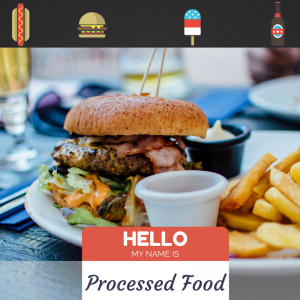
You’ve likely heard the words “processed food” in the past, and perhaps don’t think of it much while browsing the isles at the grocery store each week.
You may be wondering “What are processed foods?”… Well, you can think of them as any food that is unnatural, or does not occur naturally in nature. This includes foods that have been altered from their original form by addition of additives, preservatives, hormones, vitamins and minerals, heat treatments (that destroy natural enzymes), fatty acids, chemicals or that contain genetically altered ingredients.
Why Do Processed Foods Exist?
There are several reasons including to prolong the shelf life of the food, “enhance” flavor, make the food more esthetically appealing, and in general to try to get you (the consumer) to buy more and reduce associated cost to the food producer. Most processed foods are design with convenience in mind, ahead of your wellbeing.
Types of Processed Foods
Browsing the grocery store, you’ll begin to recognize that more and more of the foods we eat today are processed in some form. We as consumers need to keep our eyes open when purchasing food. This includes reading labels. It’s our own responsibility to choose what we eat carefully and individually to take control of our own health – no one else will do it for us!
In general most foods that are packaged, canned, or in some cases frozen are very likely to be processed in some form. Many have a very long shelf life.
More specifically, you’ll likely want to avoid these common culprits:
- Refined sugar including its variations such as corn syrup / high fructose corn syrup, dextrose, fructose, maltodextrin, sucrose, etc.
- Refined carbohydrates such as items with refined white flour.
- Artificial sweeteners such as aspartame (Equal / NutraSweet), Neotame, Saccharin (SugarTwin / Sweet’N Low) and Sucralose (a.k.a. Splenda)
- Chemically processed foods including artificial coloring, flavors, added textures or food additives.
- Soft drinks, or drinks with added sugar (including any of the refined sugar or artificial sweeteners, colorings or flavors)
- Fast foods
- Junk food
- Processed meats
- Frozen foods
- Refined wheat flour, including bleached white flour
- Boxed food items
- Margarine and hydrogenated vegetable fat
- Refined vegetable oil
- Canned items
- Genetically Modified Organisms (GMOs) and Foods – Hint: By avoiding the foods listed above, it will help reduce your exposure to the ever increasing use of unnatural and potentially detrimental effects of genetically modified foods that are more commonly used in processed foods.
In addition to avoiding the foods listed above, whenever possible it’s advisable to eat organic products including produce, milk product and meets, as organic foods are subject to less processing and reduce to odds of the damaging effects of processed foods. The more processed foods you eat, the more you are subjecting your body to its dangers.
Before explaining the dangers, it should be noted that not all processed foods are bad food choices. Though it’s always preferable to eat fresh whole foods that resemble their most natural form, some processed foods can be eaten safely as part of a balanced diet, and/or in moderation. For example, frozen vegetables or fruits are not necessarily bad choices though fresh alternatives of course are healthier.
The processed foods that are of concern are more so the chemically processed foods.
What Are the Dangers of Processed Foods?
There’s no question you want to slash your risk of disease, improve your overall health and live a longer happier life. We all do, but most of us don’t take action and don’t realize the MOST EFFECTIVE way to achieve this is by paying closer attention to what we eat!
Studies confirm that the effects of processed foods are making us sicker, fatter and shortening our lives at increasing rates.
Processed foods generally contain high amounts of refined sugar and/or carbohydrates (see the list of “refined sugar” types above). This is a major concern, as the human body was never designed to eat so much sugar. Excessive sugar consumption has been linked to many diseases including Alzheimer’s disease, diabetes, heart disease, obesity and even cancer. Consuming too much refined carbohydrates in general can also lead to issues such as insulin resistance; a precursor to many chronic diseases.
You are likely unaware of just how much sugar is in typical items you use regularly. Items that may not seem like they contain much sugar, in fact have very high amounts and it all adds up throughout the day.
On top of this, processed foods contain artificial ingredients such as preservatives, colorings and flavors that are designed in the interest of food manufactures, and not your health. Studies confirm that many of these have been linked to allergic reactions, cancer, and other diseases.
Another major issue is the amount of unhealthy fats, known as trans fats. These fats are commonly used in processed items, and has been linked to many health issues including heart disease.
These convenience foods also lead to one of the developing world’s biggest issues… obesity. Processed foods generally have much more calories vs natural alternatives and have less fiber content. This leads to eating too many of the wrong type of calories and in the end, weight gain.
|
Interestingly, recent studies on saturated fats and heart disease, show whole food sources such as eggs, dairy products, meats, etc. are healthy to eat and are not linked to heart problems; so long as trans fats are avoided.
Think twice when you eat processed foods – they’re more dangerous then they may seem.
What Should You Do?
Thankfully, there is an easy solution. All you need to remember is to buy mostly whole foods, and minimize processed items. Be mindful of what you are putting in your grocery cart.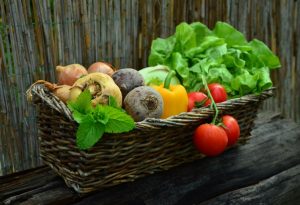
Think of it this way: If it wasn’t in that form in nature, there’s a good chance it’s not the best food choice that your body was designed to eat.
Look for fresh vegetables, fruits, unprocessed meats, eggs, nuts, seeds and avoid boxed items, cans, and convenience foods and make your meals at home.
An easy way to improve your health and avoid the dangers of processed food is to have a plan about what you will eat and to make meals from scratch at home. By doing so you avoid unhealthy purchases, and know without a doubt you are eating the right foods for optimal health and wellbeing.
If you would like help planning whole food meals please consider joining MealEasy. All of our meal plans are based on using unprocessed whole foods. You’ll see step-by-step how to make a huge variety of delicious healthy meals the easy way. Improve your diet significantly by giving it a try.
Top Weight-Loss Friendly Foods To Add To Your Diet
September 02 2016

According a report published in JAMA Internal Medicine, more than one-third of Americans are obese and overweight. Obesity is a common condition that causes life-threatening health issues, including heart disease and type 2 diabetes. Continue reading
Weight Maintenance Strategies from a Dietitian
June 21 2013
Guest Blog by Angela Dufour, MEd., PDt., IOC Dip Sports Nutrition, Nutrition in Action and Author of PowerFUEL Food: Planning Meals for Maximum Performance
As a dietitian, I regularly see clients who may easily be able to maintain healthy body weights, as well as those who struggle to reach a healthy weight. Although everyone is different and there isn’t one guaranteed, no-fail method to weight loss or maintenance, there are certain dietary approaches supported through research which can assist us in achieving a healthy weight.
Topping the list of helpful weight maintenance strategies is appropriate meal planning. Because let’s face it, we all know what it’s like to have a long, hectic day at work or a week with more things going on than hours to do them. Whenever this happens, we often find ourselves too busy and too tired when meal times roll around.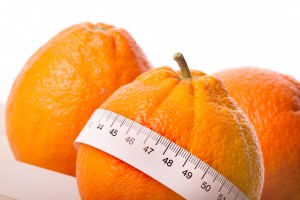
The daily rush can potentially lead to developing poor nutrition habits such as compensating pre-planned, well-balanced meals for quick and simple fixes like fast food restaurants, take-out, and processed convenience foods. Not only does this become costly, it can lead us to consume more than our adequate amount of calories, as well as higher amounts of saturated and trans fats, salt, and added sugars – additives that should be limited if we’re looking to achieve a healthy diet.
Easy Father’s Day BBQ Ideas
June 12 2013
 MealEasy’s Chef Paul recommends this fabulous heart-healthy meal for Father’s Day:
MealEasy’s Chef Paul recommends this fabulous heart-healthy meal for Father’s Day:
Grilled Pork Chops with Feta & Tomatoes
Grilled Sweet Potato & Asparagus
Fresh Fruit with Vanilla Sour Cream
It’s Father’s Day this Sunday and what better way to show dad you love him than by letting him relax so you can take over the grill!
Here’s your chance to show dad that the grill can cook more then steaks, burgers and sausages. Yes, you can even grill heart-healthy vegetables!
We’ve assembled a super easy and supremely tasty barbecue feast fit for the King of the household. With a yummy grilled pork chop featuring Mediterranean flavors, grilled asparagus and grilled sweet potato with a dessert featuring fresh fruit. Dad won’t even notice that it’s fewer than 15g of fat!! That’s less than a tablespoon including the desert! Taking care of dad’s heart on Father’s Day – what says I Love You better than that?!
So grab those BBQ tongs and get grillin’! And the best part about grilling – there’s no pots and pans to clean up afterwards!
Enjoy!
Download your own Father’s Day Menu Now
Download Father’s Day Menu Grocery List
Cooking Fiddleheads
May 28 2013
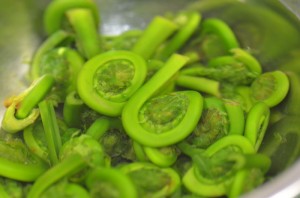 Fiddleheads are the furled fronds of a young ostrich fern commonly found near rivers and streams. Because they cannot be cultivated, fiddleheads are only available for a few weeks every spring and are harvested before the fern unrolls completely. The ostrich fern grows wild in certain parts of North Eastern North America and is the variety most likely to be on tables here. Fiddleheads are an excellent source of Omega 3 and Omega 6 as well as iron and fibre. Imagine a combination of asparagus, broccoli and green beans and you’ll get the flavour of fiddleheads.
Fiddleheads are the furled fronds of a young ostrich fern commonly found near rivers and streams. Because they cannot be cultivated, fiddleheads are only available for a few weeks every spring and are harvested before the fern unrolls completely. The ostrich fern grows wild in certain parts of North Eastern North America and is the variety most likely to be on tables here. Fiddleheads are an excellent source of Omega 3 and Omega 6 as well as iron and fibre. Imagine a combination of asparagus, broccoli and green beans and you’ll get the flavour of fiddleheads.
Cleaning Fiddleheads
Fiddleheads can be cleaned by first placing them in a colander and thoroughly rinsing them off with clean cold water. After washing, place the rinsed fiddleheads in a bowl full of clean cool water to remove the remainder of the brown papery coverings, and repeat as needed. They should appear clean at this point.
Short-term storage
Keep fiddleheads refrigerated until you are ready to cook or preserve them. They can be stored in the refrigerator for up to two weeks in a container filled with water. Make sure to change the water in the container every couple of days.
Cooking Fiddleheads
Fiddleheads can be cooked using two different methods, boiling and steaming.
- Boiling
Bring lightly salted water in a pot to a rolling boil and add washed fiddleheads without stopping the boil. If the water stops boiling you added too many fiddleheads. Therefore, make sure to boil them in enough water. If the water loses its boil, don’t worry, simply bring the water back to a steady boil and cook for 15 minutes.
- Steaming
Bring a small amount of water to a boil preferably in steamer. Add cleaned fiddleheads and steam for 10-12 minutes. Continue reading
Plan Portions and lose pounds, Naturally
February 08 2013
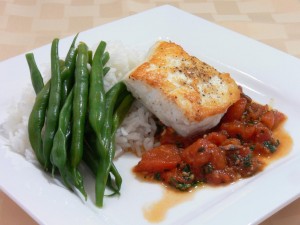 What you eat is just as important as your exercise plan. With MealEasy, you can slim down naturally with a stress-free plan.
What you eat is just as important as your exercise plan. With MealEasy, you can slim down naturally with a stress-free plan.
MealEasy blends the art of cooking with the science of nutrition to ensure each meal has maximum nutritional value to meet your specific health needs and weight goals.
Personal preference settings allow you to set your calorie ranges, eliminate certain food groups and ingredients from your diet.
Don’t want some milk products, but you do like certain cheese types or yogurt? No problem! MealEasy gives you the freedom to choose what you want and leave out what you don’t want in your diet.
You’ll be surprised by how easy it is to eat natural, fresh foods and enjoy life again. There’s no need to stress over counting calories, MealEasy does that for you!
Prepare to eat smart. Stick to your personalized MealEasy meal plan and slim down naturally.
Not all fats are created equal
January 09 2013
A few easy ways to cut the fat from our diets
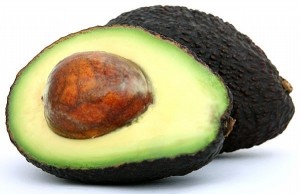
Not all fats are created equal. There are some fats that are good for you such as the monounsaturated fats found in avocados and the Omega-3 fats found in salmon and other cold water fish. The key to a healthy diet is reducing and eliminating the fats that are not so good for you. Trans fats should be avoided altogether and you should try to limit saturated fats as much as possible.
There are many ways to reduce the amount of saturated fats in your diet. One of the easiest is to choose lean cuts of meat and to trim all visible fat from your steak before cooking it; also, remove any skin from chicken and cook with less butter and cream whenever possible.
Using olive oil instead of butter will help reduce your overall fat intake and olive oil has been shown to help reduce cholesterol and high blood pressure! Try cooking with a non stick pan, this allows you to use less fat than you would with a conventional pan. Although non-stick pans have received a bad rap due to their non-stick coating compounds, there are new products available which are safe and not too expensive.
When shopping for ingredients try to find low fat or non fat versions of sour cream and yogurt. As well, keep away from ready-made snacks such potato chips and buttered popcorn. Make your own popcorn and lightly salt or season it with a mixture of spices instead of smothering it with butter.
Another great way to reduce your fat intake is to choose fruit for dessert instead of calorie rich desserts and treats. Not only will fruit increase your all important fiber intake, many fruits can help fight disease such as diabetes and certain cancers.
Here’s to a healthier, happier and leaner you in 2013!
In Praise of Slowness
May 30 2012

Did you know that you are three times as likely to be overweight if you eat too fast? Eating in a hurry has been proven to lead to all kinds of health issues as well as weight gain. Conversely, the slower you eat the fewer calories you ingest.
Eating quickly is a tough habit to break. I know because for years I was a speed eater. Working in restaurants you regularly scarf down as much as quickly as you can because you’re never sure when you’ll get a break to eat again. And, as a kid, I couldn’t wait to get outside to play so eating fast was a bad habit I grew up with.
There are steps you can take to slow down your eating habits and by extension prevent unwanted weight gain:
• Don’t wait too long between meals/snacks Try not to go more than 3 to 4 hours without eating something. Try snacks such as yogurt or fruit between main meals.
• Drink more water Have a glass of water before and during each meal; this will help you fill up your belly. Also, having a sip of water between bites will help you slow down your eating habits.
• Cut your food into smaller bites and chew chew chew Smaller pieces of food chewed thoroughly will again help with slowing down. One study showed weight loss success by chewing 20 to 30 times before the next bite. Also, chewing food thoroughly leads to better digestion as well.
• Know when to stop This is the hardest part, especially when what you’re eating is really yummy. The trick is to stop eating before you fell full. This will take some practice but learning when to stop eating is the most important thing when it comes to weight loss.
• Portion control We preach about this one a lot at MealEasy because we believe it is one of the most important and easiest ways to not overeat and therefore lose weight. Stick to your portion size.

